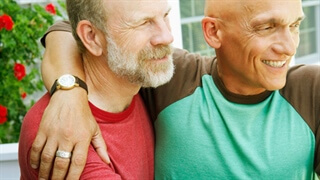First Published in CareSearch on 12 Feb 2020.
People of diverse sexualities or genders (often referred to by using the acronym LGBT, LGBTI or LGBTQ) have always existed, throughout time and across cultures. However, in Australia, we are struggling to see or celebrate our diverse older people. Why aren’t we seeing the estimated 11% of the older population being proudly queer? [1] The answer is a mix of both cultural and systematic factors, with self-imposed invisibility as a result. But why?
For a majority of their lives it was illegal for older people to be openly LGBT and a visible part of the community. For example, Tasmania only decriminalised male homosexuality in 1997. [2] Generations of illegalities and social stigmas have contributed to many older community members living with a fear of being ‘outed’. This in turn led to many developing the skills they needed to survive; like hiding their identity and their true selves. Further, trans and gender diverse people can still face more hurdles relating not only to stigma and discrimination, but medical and legislative issues in order to affirm their gender.
The LGBT community often provides safety and security through social connections and care for each other, often referred to as a ‘chosen family’. This support structure is especially important in scenarios where a biological family has rejected someone for being sexuality or gender diverse.
However, these individuals and their social connections are also ageing and may require care for themselves and often are no longer able to provide the physical, social and/or emotional support they previously did. This is just one of many scenarios that forces older LGBT people to become reliant on aged care organisations. We know that for many social ties can be lost once someone enters the aged care system – this is a particularly isolating experience, which can compound feelings of loneliness and reduce someone’s ability to disclose and be their true selves.
People may need carers in their home or may need to move into a facility, and with this comes immense vulnerability. Care is often given by strangers, and many LGBT people can feel uneasy about how carers may react to sexual orientation or gender identity. Uncertainty about carers, staff and fellow residents’ attitudes towards LGBT people, as well as fear of discrimination, mean that many do not disclose their identity. For some, this means a change from being open about their identity to ‘returning to the closet’ when entering care.
Adding to existing concerns, LGBT people are also faced with challenges when entering into aged care organisations that are faith-based or run by religious groups. This often causes fear (whether real or perceived but understandable) about how the organisation will treat LGBT people, due to long histories of religious discrimination. While this may not reflect current views, the stigma still remains.
Systematically, our health and medical systems are also lagging. Gender markers are often limited to ‘male’ and ‘female’ based on Medicare records, and not a person’s identity. Intake and assessment forms often overlook or exempt an individual’s sexuality, gender identity and/or trans experience. This does not provide clear organisational cues of LGBT safety and potentially forces an individual into a potentially difficult and triggering conversation. Not knowing this personal information makes appropriate and personalised care impossible.
Finally, activities and social events are often geared towards heterosexual and cisgender consumers. Cisgender is a term used to describe someone whose gender identity lines up with the gender they were assigned at birth. An organisation may fear being controversial and risking a perceived backlash, or they are unaware or unprepared for supporting LGBT people. Scenarios like this emphasise an organisation’s lack of understanding of LGBT community needs, only reinforcing the need to hide one’s identity.
So how do you encourage and support consumers who are ageing, as well as being of diverse sexuality or gender?
Ideas to begin to make your service welcoming to LGBT communities include:
- Being visibly inclusive through symbols, words and images
- Use of appropriate language including pronouns (for example, ’they’ or ‘them’, rather than ’him’ or ‘her’)
- Ensuring staff are educated on LGBT needs (see resources below)
- Review the client processes through a person-centred, best-practice inclusion lens
- Consulting with LGBT peak bodies and community
For too long, the health needs of LGBT people, especially older community members, have been invisible in health and wellbeing policies and service settings, despite growing evidence that the communities have disproportionate care needs.
Claire Allen, National Program Manager, Pride in Health + Wellbeing
We have seen this improve over time. As we look to the future, we hope to see LGBT people receive truly inclusive and diverse care in a variety of healthcare and support settings, which will lead to improved health and wellbeing outcomes. LGBT awareness directly relates to Aged Care Quality Standard 1: Consumer Dignity and Choice. Aligning practice to the Quality Standards enables better outcomes for older individuals.
Further resources on LGBT issues and ageing:
Pride in Health + Wellbeing: www.prideinclusionprograms.com.au/health/
ACON’s LOVE Project: www.loveproject.org.au/
The National LGBTI Health Alliance: lgbtihealth.org.au/
Alice’s Garage:alicesgarage.net/References
References:
1. Australian Human Rights Commission. Face the facts: Lesbian, Gay, Bisexual, Trans and Intersex People [Internet]. 2015 [cited 12 February 2020].
2. University of Tasmania: Centre for Tasmanian Historical Studies. Gay Law Reform [Internet]. The Companion to Tasmanian History. 2016 [cited 12 February 2020].

